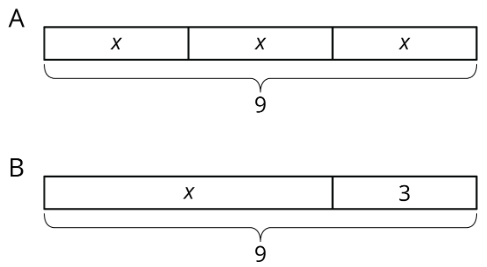31.1: Tape Diagrams and Equations
( \newcommand{\kernel}{\mathrm{null}\,}\)
Lesson
Let's see how tape diagrams and equations can show relationships between amounts.
Exercise 31.1.1: Which Diagram is Which?
- Here are two diagrams. One represents 2+5=7. The other represents 5⋅2=10. Which is which? Label the length of each diagram.

- Draw a diagram that represents each equation.
4+3=74⋅3=12
Exercise 31.1.2: Match Equations and Tape Diagrams
Here are two tape diagrams. Match each equation to one of the tape diagrams.

- 4+x=12
- 12÷4=x
- 4⋅x=12
- 12=4+x
- 12−x=4
- 12=4⋅x
- 12−4=x
- x=12−4
- x+x+x+x=12
Exercise 31.1.3: Draw Diagrams for Equations
For each equation, draw a diagram and find the value of the unknown that makes the equation true.
- 18=3+x
- 18=3⋅y
Are you ready for more?
You are walking down a road, seeking treasure. The road branches off into three paths. A guard stands in each path. You know that only one of the guards is telling the truth, and the other two are lying. Here is what they say:
- Guard 1: The treasure lies down this path.
- Guard 2: No treasure lies down this path; seek elsewhere.
- Guard 3: The first guard is lying.
Which path leads to the treasure?
Summary
Tape diagrams can help us understand relationships between quantities and how operations describe those relationships.

Diagram A has 3 parts that add to 21. Each part is labeled with the same letter, so we know the three parts are equal. Here are some equations that all represent diagram A:
x+x+x=123⋅x=21x=21÷3x=13⋅21
Notice that the number 3 is not seen in the diagram; the 3 comes from counting 3 boxes representing 3 equal parts in 21.
We can use the diagram or any of the equations to reason that the value of x is 7.
Diagram B has 2 parts that add to 21. Here are some equations that all represent diagram B:
y+3=21y=21−33=21−y
We can use the diagram or any of the equations to reason that the value of y is 18.
Practice
Exercise 31.1.4
Here is an equation: x+4=17
- Draw a tape diagram to represent the equation.
- Which part of the diagram shows the quantity x? What about 4? What about 17?
- How does the diagram show that x+4 has the same value as 17?
Exercise 31.1.5
Diego is trying to find the value of x in 5⋅x=25. He draws this diagram but is not certain how to proceed.

- Complete the tape diagram so it represents the equation 5⋅x=35.
- Find the value of x.
Exercise 31.1.6
Match each equation to one of the two tape diagrams.
- x+3=9
- 3⋅x=9
- 9=3⋅x
- 3+x=9
- x=9−3
- x=9÷3
- x+x+x=9

Exercise 31.1.7
For each equation, draw a tape diagram and find the unknown value.
- x+9=16
- 4⋅x=28
Exercise 31.1.8
A shopper paid $2.52 for 4.5 pounds of potatoes, $7.75 for 2.5 pounds of broccoli, and $2.45 for 2.5 pounds of pears. What is the unit price of each item she bought? Show your reasoning.
(From Unit 5.4.5)
Exercise 31.1.9
A sports drink bottle contains 16.9 fluid ounces. Andre drank 80% of the bottle. How many fluid ounces did Andre drink? Show your reasoning.
(From Unit 3.4.5)
Exercise 31.1.10
The daily recommended allowance of calcium for a sixth grader is 1,200 mg. One cup of milk has 25% of the recommended daily allowance of calcium. How many milligrams of calcium are in a cup of milk? If you get stuck, consider using the double number line.

(From Unit 3.4.2)


